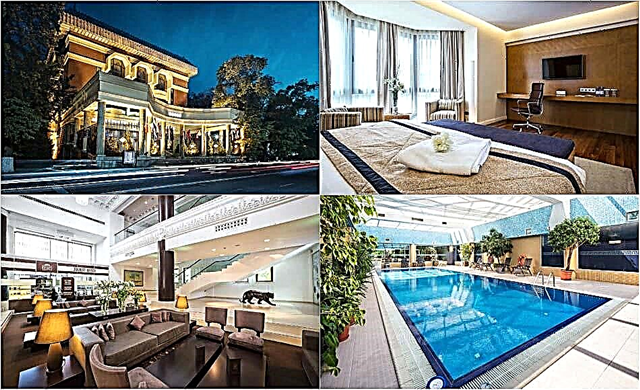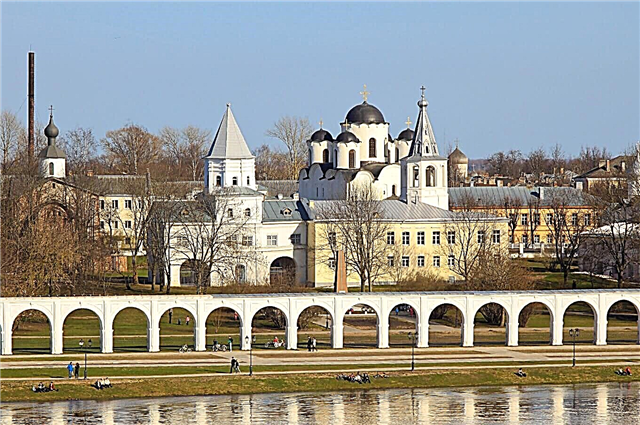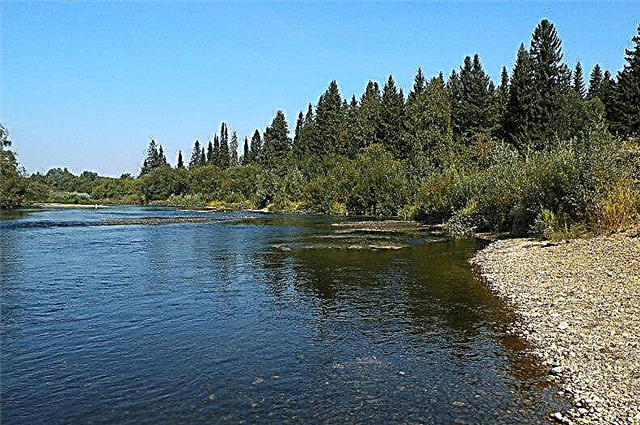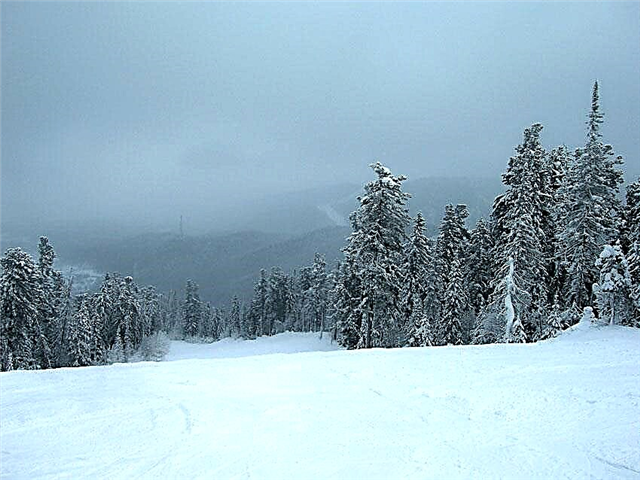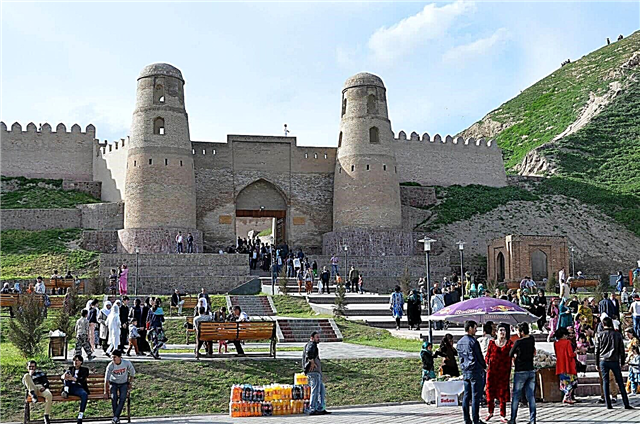The main wealth of the Primorsky Territory is its amazing nature. Virgin forests, picturesque hills, the coast of the Sea of Japan, the centuries-old Ussuri taiga, the majestic slopes of the Sikhote-Alin. On the territory of the region there are 6 reserves and 3 national parks with unique flora and fauna. There is even a marine reserve, its waters and coastal areas are inhabited by more than 5,000 species of flora and fauna.
In addition to natural attractions, the Primorsky Territory is also rich in historical monuments. Most of them are associated with the region's glorious military past. This is the legendary Vladivostok fortress, and the remains of the Voroshilov battery on one of the islands, and a submarine-museum, and a pre-revolutionary patrol ship-museum and many others.
The most interesting and beautiful places in the Primorsky Territory
What to see and where to go? The best objects of tourism and active recreation!
Cable-stayed bridges of Vladivostok
Two cable-stayed bridges in Vladivostok, built in 2012, are among the five largest bridges of this design in the world. The span of the Russian Bridge is over 1 km, the total length of the roadbed is 3 km. The length of the Golden Bridge is 1388 meters, it serves as a connecting link between the two shores of the central bay of the Golden Horn. From here Vladivostok began to grow, there are seaports, many ships, a magnificent embankment.

Ussuriysky reserve
The territory of the protected area is located in the Ussuriysky and Shkotovsky regions. Its main asset is the large virgin forests with valuable conifers preserved in this area. Forests cover 99% of the reserve. The fauna is represented here by red deer, white-breasted bear, wild boar, badger, as well as by the “Red Book” East Siberian leopard, black stork, Amur tiger, Ussuri newt.

Reserve Kedrovaya Pad
A picturesque corner of pristine Far Eastern nature, one of the oldest reserves in Russia. It was organized back in the pre-revolutionary years and covers an area of 17897 hectares. Here you can find quite rare Amur leopards, Amur cats, Far Eastern leopards, sika deer, mandarin ducks, blue magpies, short-toed hawks. In terms of plant species diversity, the reserve has no equal in the entire Far Eastern Territory - about 900 species.

Sikhote-Alin nature reserve
The idea of creating a reserve arose in the early 30s of the last century due to the fact that the territory of Sikhote-Alin was chosen by hunters, poachers and forest cutters. Today the reserve is included in the UNESCO World Heritage List. It features plants and animals from different climatic zones. One of its phenomena is the tropical rhododendron. A local attraction is Lake Blagodatnoye, where bears, tigers, elks, and deer come to drink.

Primorsky Oceanarium
The third largest oceanarium in the world on the Russian Island is distinguished by its unusual external and internal design. Its building is made in the shape of a giant shell. The interiors are striking with bright colors, huge models of ancient animals, artificial stones and ice, hundreds of aquariums with clear water, modern multimedia devices. The territory is divided into 9 thematic zones, where the inhabitants of all the world's oceans and freshwater bodies are represented.

Vladivostok fortress
The Vladivostok fortress was intended to defend the port from enemy invasions from the sea and land. At the turn of the 19th-20th centuries, fortifications of unique strength and reliability were built, which were complex engineering structures. For a century, it was the most powerful stronghold in the history of Russia. At the beginning of the 90s, the last time during the exercises were the shots of fortress cannons, now a museum is open here.

Lake Khanka
The largest freshwater reservoir in the Far East is located on the border of China and Russia. The depth in the lake is shallow, the water warms up quickly, so it is very crowded here during the beach season. The lake and its surroundings belong to the Khanka nature biosphere reserve. It contains 336 bird species, 29 mammal species, 9 rodents, 7 reptiles, 6 amphibians, 75 fish. The flora of the reserve is represented by 620 plant species.

Putyatin Island
Magnificent nature, clear clear sea, springs with drinking water, rocks that look like strange animals, numerous picturesque bays, magnificent underwater world, sandy beaches, historical monuments - all this is Putyatin Island in the Peter the Great Bay. One of its attractions is Goose Lake, and the lotuses blooming on it in the summer, listed in the Red Book. A ferry crossing connects the island with the mainland.

Far Eastern Marine Reserve
The reserve in the Peter the Great Bay was founded in 1978. 97% of its territory is seawater with hundreds of fish species, rare algae, molluscs, coelenterates and aciculars that need protection. There are 11 islands in the reserve. 780 species of plants, 350 species of birds are registered on them. Astafiev Bay in the reserve area is a popular vacation spot with clear, bright blue water, white sandy beach, and amazing wildlife.

Benev waterfalls
The decoration of southern Primorye, the most visited waterfalls by tourists. They are located in the Przhevalsky mountains, formed by the waters of the Elomovsky spring, which originates from the highest mountain peaks. A rumbling stream of water falls from sheer cliffs and forms a cascade of numerous magnificent waterfalls. There are about 30 of them in total. The first - the largest - has a height of over 20 meters. The territory of the waterfalls has been assigned the status of a protected natural monument.

Mount Livadia (Pidan)
One of the most mysterious and visited mountains in southern Primorye, the height is about 1300 meters. It is remarkable for the huge stones scattered on the slopes. And its name is translated as "stones poured by God." According to legends, at the time of Bohai, the mountain was sacred, a magic crystal was installed on its top, and only priests could climb to it. And the myth of the flying man living here is also popular. Also of interest are the large dolmens on the top of the mountain.

Botanical Garden-Institute FEB RAS
The Botanical Garden in Vladivostok owns an area of 169 hectares, most of it is occupied by vegetation typical for this natural zone - cedar, ash, and fir plantations. Of particular interest is the collection of decorative plants - chrysanthemums, irises, phloxes, roses, etc. The total number of plants in the garden is 3100 species. Also, research in the field of botany, genetics, ecology is carried out here, 7 scientific laboratories work.

Lighthouse "Tokarevskaya cat"
An ancient lighthouse in the form of a 12-meter white stone tower is located on the very outskirts of an artificially created sandy spit - Tokarevskaya Koshka, on the Shkot Peninsula. It was built in 1910. The need for a lighthouse was caused by the shallow bottom and strong underwater currents in the area. In the summer season, a wonderful beach is open on the spit; spotted seals - seal seals often swim here. Tourists are not allowed to enter the lighthouse, as it is still active.

Call of the Tiger National Park
The main goal of creating the park in 2007 was to preserve unique natural complexes and objects, the main of which are the Amur tigers. Most of the complex is occupied by birch, oak, spruce-fir, cedar forests. In addition to tigers, here you can find Himalayan, brown bear, forest cat, red deer, musk deer.Natural attractions of the park are the Cloud Mountains, Sestra, Brother, a series of Milogradov waterfalls.

Seaside Safari Park
Representatives of the Primorsky Territory fauna live in a fenced area of the forest near the village of Shkotovo, without trellises and in their usual conditions. Among them are wolves, bears, musk deer, deer, wild boars, lynxes, badgers, forest cats, raccoon dogs, 17 species of birds of prey. Even the Amur tigers live here in freedom, and you can watch them from the platforms raised to a safe height. The unique park was organized in 2007.

Automotive Antique Museum in Vladivostok
The original collection of the museum will especially appeal to lovers and connoisseurs of rare technology. Six halls showcase more than fifty restored motorcycles and cars of various brands - products of the domestic and foreign automotive industry of the last century. Part of the exhibition is located in the open air, including military equipment. All the exhibits of the museum are on the move, periodically they are used for filming films and military parades.

Intercession Cathedral of Vladivostok
The main temple of Vladivostok has a difficult fate. It was built at the beginning of the last century, had many windows, a gilded iconostasis, well-made icons, bells, five gilded domes. It was designed for 700 people. However, under Soviet rule, it was first plundered and closed, and later blown up. In 2004, restoration work began on the old preserved foundation. In 2008, the first liturgy was held in the renovated church.

Memorial ship Red pennant
The veteran of the fleet on Korabelnaya embankment has a glorious history. The ship was built in St. Petersburg in 1910, in the Far East it was used to transport passengers and cargo, during the revolution the crew took the side of the Bolsheviks. Then the ship spent 2 years in China, since 1923 it was returned and enlisted in patrol ships, took part in the events of the Great Patriotic War. Since 1958, it has anchored in a picturesque bay and turned into a museum.

Nikolaev triumphal gates
One of the most beautiful and symbolic buildings in the capital of Primorye was built in 1891. At that time, the future Emperor of Russia Nicholas II decided to visit the city as part of his trip around the world. It was in honor of this solemn event that the decision was made to build the Triumphal Gate. In the 30s, the symbol of monarchical power was blown up by the Bolsheviks, and only in 2003 the gate was rebuilt.

Voroshilov battery
The legendary fortification is located in the south of Russky Island. The coastal battery was built in the 30s of the last century to protect against enemy attacks from the sea. Two towers with guns were placed in the lowland between the hills so that they were not visible from the sea. Under the towers are underground bunkers of several floors, capable of withstanding powerful bomb attacks. Since 1997, the battery has been removed from service, and a museum has been created on its basis.

Vladivostok funicular
For more than half a century, two pretty carriages in red and blue have been running daily along a single-track track connecting the upper and lower points of the Eagle's Nest hill. The capacity of the trailers is up to 40 people, they cover the 180-meter route in 2 minutes. There is a popular viewing platform at the top station. To date, this type of transport has remained only in Sochi and Vladivostok.

Monument to the Fighters for Soviet Power in the Far East
The opening of the largest monument in the Far East took place in 1961. It includes three sculptural elements. In the center is a 30-meter figure of a Red Army soldier with a banner and a battle tube in his hands. On the right - the figures of a sailor, a worker and a soldier, at their feet - the defeated two-headed eagle of autocracy. Left - a group of partisans who liberated the city from the Japanese invaders. All sculptures are cast from bronze, the pedestal and podiums are from granite.

Don't Miss: 30 of Vladivostok's Best Monuments
Arsenyev Primorsky State Museum
One of the oldest museums in the Far East is located in a former merchant house built in 1904 in the central part of Vladivostok. It contains the largest collection of priceless artifacts in the region - natural, historical, artistic, archaeological and ethnographic. In total, there are about 600 thousand museum items. The museum's expositions are supplemented with multimedia services, all halls have a Wi-Fi network, photography is allowed.

Askold Island
One of the most beautiful but inaccessible islands is located in the Peter the Great Bay. It attracts with its amazing landscapes, clear water, rich underwater world, numerous tame seagulls. For a long time there was a sika deer nursery here - the only one in the world. There are gold deposits on the island. One of the capes is crowned with an ancient lighthouse, built before the revolution. Abandoned military equipment can also be found here.

Mount Sister
Sister Mountain in Nakhodka is always crowded. It is not high - just over 300 meters, and even children can climb it. The mountain is a giant ancient reef, which is estimated to be 250 million years old. It is almost a perfect pyramid in shape. Climbing to its top, you can endlessly admire the picturesque landscapes below. Since 1984 Sister has been a natural monument. In the neighborhood there are smaller mountains - Brother and Nephew.

Dragon park
The name of this unusual park was given by natural stone compositions resembling giant prehistoric animals. The complex of rocky outcrops covers an area of 36 km2 and scientists believe that it was formed as a result of centuries of weathering. Although there are supporters of the unnatural origin of stone sculptures. They look very realistic - turtles, crocodiles, small and large dragons, dinosaurs, snake heads.

Chandalaz ridge
An ancient marine coral reef in the middle of the taiga is the “divine” Chandalaz ridge. Its highest peak reaches 760 meters. The Chandalaz caves are shrouded in legends and myths. They say that they contain priceless gold treasures of the Jurchen empire, destroyed by the warriors of Genghis Khan. Chandolaz is known for its unusual vegetation. In autumn, the oaks growing on it turn scarlet, and in spring the wild rosemary flames purple.

Telyakovsky Bay
The southernmost bay of the marine reserve, in addition to clean water and beautiful beaches, has several attractions. Rare burial pines and rhododendrons grow here. In the southern part, the remains of the coast guard artillery installations have been preserved. Seals swim here - seals, and sometimes sharks. Of greatest interest is the islet of the Tormented Heart. Here, in a natural bath between the rocks, a boulder rests, making sounds like heartbeats.

Kekura Two Brothers and Briner Lighthouse
One of the most famous places in the Far East until 1997 was captured on a banknote in Russia. Two rocks-kekura majestically rise above the waters of the Sea of Japan in Rudnaya Bay, not far from Cape Briner. Kekuras are located on a common platform, 130 meters from the coast, their age is estimated at 60 million years. The nearby Briner Cape is two rocky hills, on the top of one of which a lighthouse in the form of a white stone tower was built in 1950.

Dersu village
The village of Dersu is located in a deep taiga forest, where there are no shops, no hospital, or mobile communications. Since 2009, Old Believers who have come from South America have lived here. Their ancestors were forced to flee abroad back in the 30s, when the Bolsheviks began repressions against the believers. But they always considered Russia their homeland and did not lose hope of returning. The community consists of 72 people, they are slowly settling in, they are engaged in agriculture.


